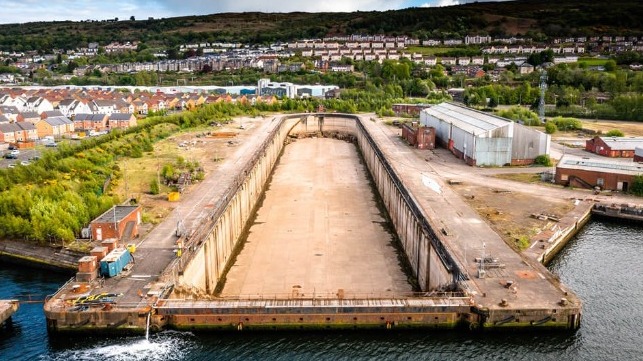Historic Dry Dock Becomes Scottish Ship Recycling Facility

After sitting largely unused for nearly 20 years, one of the largest and most celebrated dry docks in Scotland will be reborn for the ship recycling industry. Atlas Decommissioning, which specializes in the end-of-life disposal of marine infrastructure as an offshoot of a U.K. commodities firm, has received a license and signed a long-term lease for the Inchgreen Dry Dock facility near Greenock, Scotland.
ATLAS Decommissioning reports that it already has contracts in place for the recycling operation. The company said it would be working with “blue chip container lines for multiple vessels that they are removing from their current trading fleet.”
The dry dock located near Glasgow, Scotland has a long history serving some of the U.K.’s most famous ships. The famed ocean liner Queen Elizabeth 2 used the facility when it was fitting out in the late 1960s at its builder’s John Brown & Company. The successor company, Upper Clyde, however, was in decline and ended shipbuilding by the early 1970s. The dry dock is today owned by Peel Ports, which had been seeking new uses for the facility.
“Inchgreen Dry Dock, as well as its size, also has direct access to very deep water. As a facility for the contracts we have in place I’d go as far as to say it is unique in the U.K.,” said Mike Wood, Project Director of ATLAS Decommissioning.
The dry dock is 984 feet long and 147 feet wide. It is part of a 31-acre site with a dock measuring over 1,200 feet. The minimum depth is approximately 25 feet and with direct access to the ocean it is seen as a strong location for the new operation.
“There is also the attraction of the skilled workforce in Inverclyde due to its shipbuilding legacy,” said Wood. “What we are doing here is essentially shipbuilding in reverse and requires much of the same engineering excellence and expertise.”
Most of the local officials are hailing the agreement that they believe will bring work to the local area for at least 100 people. However, some are lamenting the loss of shipbuilding opportunities, especially as the U.K. embarks on an aggressive program to build its offshore wind energy industry. Other historic shipyard facilities, including Appledore and Harland & Wolff in Northern Ireland, are working to service the new offshore industry.
Peel Ports announced in 2020 that the dry dock facility was being used to support the construction of the new pontoon for the Greenock cruise terminal. At the time, four mobile cranes were brought in to replace the facility’s previous cranes which had been torn down in 2017. Peel said that it expected the new work was the beginning of a steady stream of assignments for the dry dock, which they said remained the largest mainland dry dock in the U.K.
